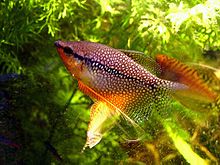Pearl gourami
| Pearl gourami | |
|---|---|

| |
| Scientific classification | |
| Domain: | Eukaryota |
| Kingdom: | Animalia |
| Phylum: | Chordata |
| Class: | Actinopterygii |
| Order: | Anabantiformes |
| Family: | Osphronemidae |
| Genus: | Trichopodus |
| Species: | T. leerii
|
| Binomial name | |
| Trichopodus leerii (Bleeker, 1852)
| |
| Synonyms | |
| |

The pearl gourami (Trichopodus leerii) is a species of gourami native to Southeast Asia.[2]
Description
These fish reach about 12 centimetres (4.7 in) TL.[2] The body is a brownish-silver colour, covered in a pearl-like pattern with a distinct black line running from the fish's head, and gradually thinning towards the caudal fin.this fish has given rise to many popular names, such as the lace gourami and the mosaic gourami.
Male specimens of this fish, typical of many gouramis, are generally larger and more colourful than their female counterparts. They exhibit bright orange colouring around the throat region, which at breeding time becomes much brighter and is used to court the female. Males also exhibit somewhat of an orange tinge in their fins, with the exception of the caudal (tail) fin. The male also has longer fins, with a more pointed dorsal fin and extended anal fin rays.[3]
Distribution and habitat
The pearl gourami is native to Thailand, Malaysia and Indonesia (where it is found on the islands of Sumatra, and Borneo). It occurs in lowland swamps with acidic water.[2] This fish prefers the top and middle levels of the water.[3]
In the aquarium
This section contains instructions, advice, or how-to content. (November 2011) |
Tank requirements
A tank with a volume of 120 litres (30 gallons) or over is adequate for a pair of pearl gouramis, although anything above that volume is greatly recommended, since these fish show signs of stress, abnormal aggression, and illness when feeling confined.[4] Preferred tank temperatures are 22–28°C (72–82F).[3] Tanks with surfaces exposed to fresh air are recommended so that the pearl gourami's labyrinth organ can function correctly. As with any tropical aquarium, adequate filtration, lighting, substrate and decorations, plants, and proper care are required. The pearl gourami is a territorial fish and should only be suited in a community tank with fish of similar size to it.[3] However, this fish may be somewhat timid or shy, and should not be kept with fish that are too boisterous or aggressive.[4] In fact, in the first several days or weeks, these fish typically show extreme shyness and timidness, spending a great deal of time hiding, regardless of tank-mates or water properties. If in proper conditions, however, they will outgrow this and become more open and gregarious, becoming social fish. Although somewhat hardy, pearl gouramis can be vulnerable to disease. Clean tanks are a must for pearl gouramis. Many gouramis feel more at home when the tank is furnished with many plants, decorations, and ornaments which provide safe refuges for the fish in times of stress.
Breeding
The pearl gourami is a bubble nest builder that uses plants to help bind together the bubbles. The water level should be reduced to 20 cm (8 in) during spawning ,[5] and the temperature should be approximately 28 °C (82 °F) and with a pH of around 7. After spawning both adults cannot be kept together. The eggs hatch after two days and the fry become free swimming three days later (Ter Morshuizen 2007). When they commence with swimming freely the fry can be fed infusoria and brine shrimp, and a week later finely ground flakes. Freeze-dried tablets may also be fed to older fry. The temperature needs to be high (about 84 °F) and with little or no water movement. Since they are air breathers, filtration is not necessary.
The pearl gourami has a very unusual and beautiful mating dance. The male builds a nest of tiny, durable bubbles. The female takes a position under the nest and the male curves his body tightly around her, from underneath, as if holding her. Her body quivers while she expels a few eggs. Next he releases her and picks up the eggs in his mouth, as they are slowly sinking, then he spits them into the bubble nest. This sequence is repeated several times, till she has completed her egg-laying.
The fry are tiny at hatching. The male takes responsibility for the fry, rescuing them and spitting them back into the nest if they fall out. Some tend to grow faster than others, and will exhibit fratricide, eating their smaller siblings.
References
- ^ Vidthayanon, C. 2012. Trichopodus leerii. In: IUCN 2013. IUCN Red List of Threatened Species. Version 2013.2. <www.iucnredlist.org>. Downloaded on 09 April 2014.
- ^ a b c Froese, Rainer; Pauly, Daniel (eds.). "Trichopodus leeri". FishBase. February 2014 version.
- ^ a b c d Sanford, Gina (1999). Aquarium Owner's Guide. New York: DK Publishing. ISBN 0-7894-4614-6.
- ^ a b Axelrod, Herbert R. (1996). Exotic Tropical Fishes. T.F.H. Publications. ISBN 0-87666-543-1.
- ^ Breeding pearl gouramis <[1]>

